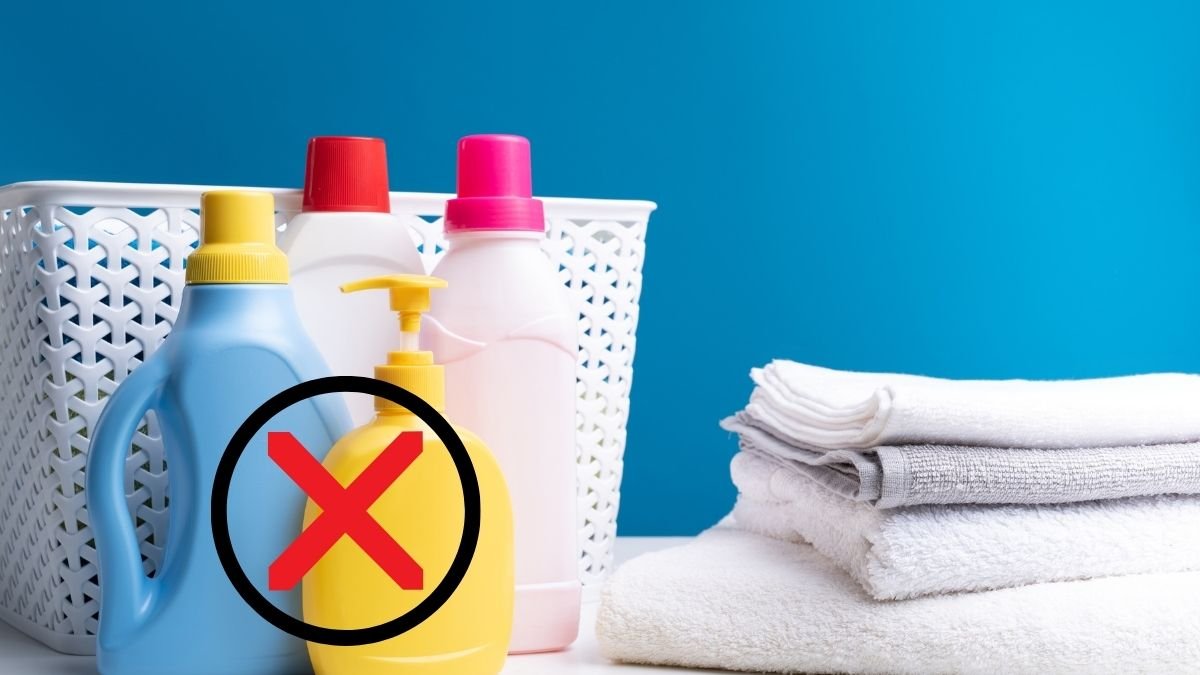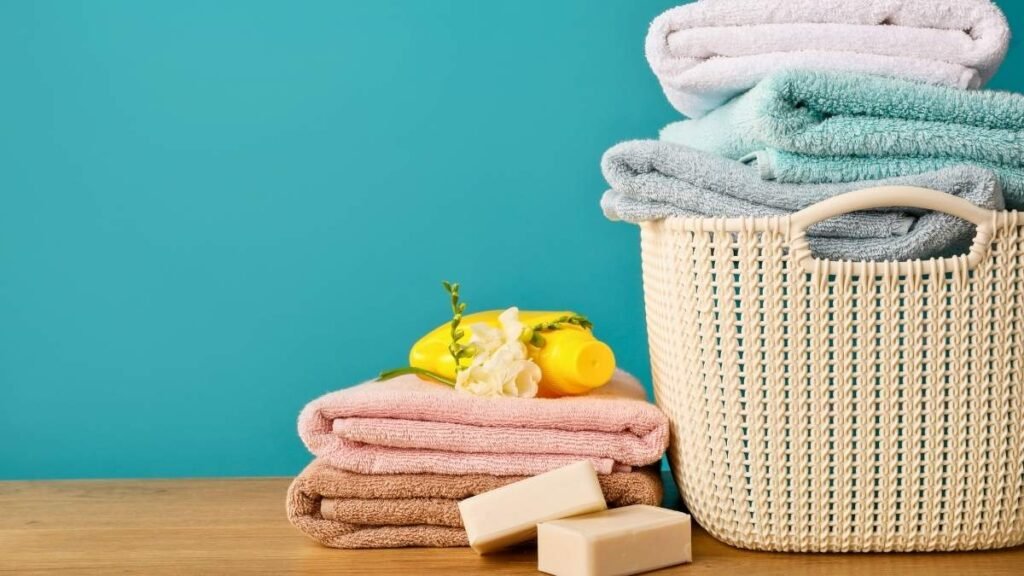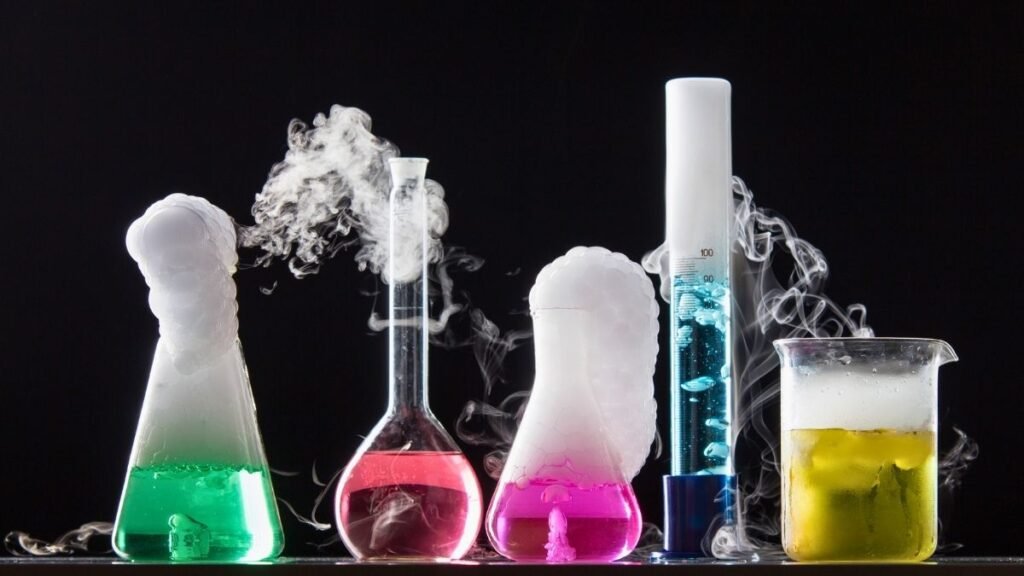
Let’s have a little heart-to-heart. There are few things in this world as comforting as the smell of fresh laundry, right? For years, that scent was my signal for a job well done. Pulling a warm, fragrant pile of clothes from the dryer felt like a hug from my home. It was the smell of clean, of care, of everything being right in my little world.
I was, and I’m not ashamed to admit it, emotionally attached to that specific “April Fresh” or “Mountain Rain” aroma. Companies know this, of course. They’ve spent millions of dollars hard-wiring our brains to associate those powerful, lingering scents with the very idea of cleanliness.
Your Dryer Vent is an Unregulated Smokestack
When heated, the chemicals hidden under the word “fragrance” are released from your home. Here’s what one study found coming out of a single dryer vent:
A cocktail of chemicals released into the air you breathe.
As classified by the U.S. Environmental Protection Agency (EPA).
Including Benzene and Acetaldehyde, which have no safe level of exposure.
Source: Research by Dr. Anne Steinemann analyzing emissions from scented laundry products.
But a few years ago, a nagging question started to creep in. I was on a journey to clean up other areas of my life—eating whole foods, switching to cleaner beauty products—and I couldn’t ignore the laundry room any longer. If I was so careful about what I put in my body, what about what I put on it, 24/7? That question sent me down a rabbit hole, and what I found was, frankly, horrifying. That comforting scent I used to love? I discovered it was a mask for a toxic cocktail of chemicals I was unknowingly wrapping my family in every single day.
Today, I’m sharing everything I learned. We’re going to pull back the curtain on the laundry industry, expose the hidden dangers lurking in your dryer sheets, and then, I promise, I’ll introduce you to the simple, cheap, and wonderfully effective solution that changed my laundry game forever.

The “Fragrance” Façade: What’s Really in Your Dryer Sheets?
My investigation started with a simple question: what is that scent? I turned over a box of dryer sheets and saw the ingredient list. It was short, vague, and contained one word that would become the villain of my story: “Fragrance.”
Per fragranced product, not listed on the label, according to the EWG.
Including 7 hazardous air pollutants released into your home and neighborhood.
Benzene and Acetaldehyde, with no safe exposure level, are vented from dryers.
Estimated cost of healthcare and lost productivity from daily exposure to EDCs.
What I learned is that this single word is protected as a “trade secret” under the U.S. Fair Packaging and Labeling Act of 1966. This “fragrance loophole” allows companies to hide a proprietary blend of potentially hundreds of chemicals without ever having to list them on the label. According to the Environmental Working Group (EWG), the average fragranced product contains about 14 secret chemical ingredients not listed on the label, many of which are linked to hormone disruption and have never been tested for human safety in personal care products.
It turns out that the warm, soft, static-free, and fragrant clothes we love are the result of a very specific chemical concoction. The very things that make dryer sheets seem so effective are, paradoxically, what make them so potentially harmful. The better a product is at making clothes feel unnaturally soft or holding a scent for weeks, the more likely it is to be loaded with problematic ingredients.
Let’s break down the main players in this chemical cocktail.

| Chemical Category | Chemical Name(s) | Their Job in the Dryer Sheet |
| Softening Agents | Quaternary Ammonium Compounds (QACs or “Quats”) | These chemicals, like dipalmethyl hydroxyethylammoinum methosulfate, have a positive charge that coats your negatively charged fabric fibers. This invisible chemical layer reduces static and makes the fabric feel soft to the touch. |
| Fragrance Extenders | Phthalates | These are endocrine-disrupting chemicals used to make scents last longer. That “fresh scent” that lingers in your closet for weeks? You can thank phthalates for that. |
| Scent Compounds | Synthetic Musks | Originally derived from animals, these are now man-made chemicals designed to provide that signature “clean” or “musky” base note. They are incredibly common in laundry products. |
| Solvents & Carriers | Volatile Organic Compounds (VOCs) | Chemicals like acetaldehyde, benzene, and ethanol are used to help dissolve and disperse the fragrance chemicals. They are released as toxic gases from your dryer vent when heated. |
| Other Additives | Formaldehyde, Benzyl Acetate, Chloroform | This group includes known carcinogens, respiratory irritants, and neurotoxins that have been identified in various laundry products. |
Seeing this list, I felt a pit in my stomach. These weren’t just benign ingredients; they were serious chemicals with documented health risks. My comforting laundry routine was starting to feel a lot less comforting.
From Headaches to Hormones: The Real Health Cost of “Clean” Clothes
Impact on Well-being
Dr. Anne Steinemann’s research found a significant portion of the population reports adverse health effects from exposure to scented laundry products vented from neighboring homes.
- 🤧Respiratory Issues: Chemicals like QACs are known asthmagens, triggering asthma attacks.
- 🧠Neurological Problems: Migraines and headaches are common complaints.
- 👶Hormone Disruption: Phthalates interfere with the body’s natural hormones, posing risks for development and fertility.
Once I knew what was in the dryer sheets, I needed to understand what they were doing to us. The exposure happens in two main ways. First, through dermal absorption: these chemicals are designed to leave a residue that clings to fabric, which then sits against our skin—our body’s largest organ—all day and night, absorbing directly into our bloodstream. Second, through inhalation: when heated, dryer sheets release a plume of VOCs and fragrance chemicals out of the dryer vent and into the air in and around our homes.
I was shocked to learn that our dryer vents are essentially unregulated smokestacks on our homes. Dr. Anne Steinemann, a professor and world-renowned expert on environmental pollutants, puts it bluntly: “If they’re coming out of a smokestack or tail pipe, they’re regulated, but if they’re coming out of a dryer vent, they’re not”.
Her groundbreaking research analyzed the emissions from dryer vents using popular scented laundry products. The results were staggering. She identified more than 25 different Volatile Organic Compounds (VOCs), including seven classified as hazardous air pollutants by the EPA. Two of those— acetaldehyde and benzene—are known carcinogens with no safe exposure level.
These unregulated emissions don’t just pollute our homes and our neighborhoods; they have a direct impact on our health, ranging from common irritations to silent, long-term damage.
Skin Irritation and Eczema

This is often the first and most obvious sign of a problem. The same chemicals that coat fabrics can be incredibly irritating to the skin, causing contact dermatitis, red rashes, itching, and even blisters. For those with sensitive skin or eczema, laundry products are a common trigger.
Many people have shared stories of their skin issues clearing up dramatically after they ditched their conventional detergents and dryer sheets. One doctor I read about recalled a patient with a terrible, uncontrollable rash that only cleared up after they discovered he was allergic to formaldehyde, a chemical sometimes used in wrinkle-free clothing and laundry products.
Respiratory Issues and Asthma
If you or a family member suffers from asthma, allergies, or frequent headaches, your laundry room could be a major culprit. Quaternary Ammonium Compounds (QACs) are known asthmagens, meaning they can trigger asthma attacks or even cause asthma to develop in previously healthy people.
Dr. Steinemann’s research found that over 12.5% of people reported health problems like asthma attacks, migraines, and respiratory trouble that they directly attributed to scented laundry products venting from a neighbor’s home. In online forums, people suffering from severe asthma have shared their decision to switch to wool dryer balls specifically to avoid these triggers.
The Invisible Threat: Endocrine Disruption
This was the part that truly terrified me. Many of the chemicals in dryer sheets are Endocrine Disrupting Chemicals (EDCs). In simple terms, EDCs are chemical imposters. They look and act enough like our natural hormones (like estrogen or testosterone) that they can mimic, block, or scramble the messages our endocrine system uses to run our bodies.
This isn’t a case of “the dose makes the poison.” The Endocrine Society warns that even incredibly low doses of these chemicals can have significant effects, especially during critical developmental windows like pregnancy and childhood.
The main EDCs hiding in your laundry products are:
- Phthalates: Used to make fragrances last, these are potent estrogen-mimickers linked to reproductive harm and developmental problems in children.
- Synthetic Musks: These fragrance chemicals can also alter estrogen activity and have been linked to gynecological issues like ovarian failure and infertility.
- Parabens: Often used as preservatives, these also mimic estrogen and have been found in breast cancer tissues.
The health consequences linked to EDC exposure are devastating: infertility, birth defects, developmental delays, ADHD, obesity, diabetes, and an increased risk of hormone-related cancers like breast and prostate cancer. The scale of this problem is almost unbelievable. A 2016 study from NYU Langone estimated that daily exposure to EDCs costs the U.S. economy over $340 billion a year in healthcare costs and lost productivity.
What’s worse is that this isn’t a one-time exposure. Chemicals like synthetic musks are designed to be persistent. They are lipophilic (meaning they are stored in fat) and bioaccumulate in our bodies over time—in our fat tissue, our blood, and even in breast milk that is passed on to infants. Every load of laundry using these products adds another small deposit into a “body burden” account, a toxic debt our health may one day be forced to pay.
Who Is Most at Risk?
While these chemicals are a concern for everyone, some populations are far more vulnerable. The developing systems of pregnant women, fetuses, infants, and children are exquisitely sensitive to hormonal signals, making EDC exposure particularly dangerous for them. The elderly and anyone with a compromised immune system or pre-existing conditions like asthma or eczema are also at higher risk.
My Laundry Game-Changer: Discovering the Magic of Wool Dryer Balls
Dryer Sheets ☠️
- 🧪 Contains a hidden mix of toxic chemicals.
- 💸 A constant, recurring expense.
- 🗑️ Single-use sheets create landfill waste.
- 📉 Coats fabrics, reducing towel absorbency.
Wool Dryer Balls ❤️
- 🌿 100% natural, hypoallergenic, and chemical-free.
- 💰 One-time purchase lasts for over 1,000 loads.
- ♻️ Reusable, zero-waste, and biodegradable.
- ✨ Naturally softens fabric and maintains absorbency.
Reading all of this, I felt overwhelmed and, honestly, a little betrayed. I immediately threw out my boxes of dryer sheets. But then what? I still wanted soft, static-free clothes. I tried adding vinegar to the rinse cycle (which works pretty well, but my laundry sometimes had a faint salad smell) and baking soda. Then, a friend mentioned wool dryer balls.
I was skeptical. How could these simple, fuzzy balls possibly replace my high-tech dryer sheets? But I was desperate for a safe solution, so I bought a pack. And let me tell you, it was a total game-changer. I quickly went from a skeptic to a full-blown evangelist, and I’ll never go back.
So, what are they? Wool dryer balls are simply tightly felted balls of 100% natural wool. That’s it. No chemicals, no fragrances, no secrets.
Their magic isn’t chemical; it’s mechanical. As they tumble around in your dryer, they work in three ways:
- They separate your laundry: The balls bounce between layers of fabric, preventing clothes and sheets from twisting into a giant, damp clump.
- They improve airflow: This separation allows hot air to circulate much more efficiently, reaching every part of your laundry.
- They soften fabric: The constant, gentle friction of the wool fibers massages your clothes, naturally softening them without any chemical coatings.
The solution to a complex chemical problem turned out to be beautifully, wonderfully simple. It was a powerful lesson: sometimes the best, healthiest solutions don’t come from a lab, but from nature itself.
To see just how big of an upgrade this switch is, let’s put them head-to-head.
| Feature | Conventional Dryer Sheets | Wool Dryer Balls |
| Health Impact | Full of potential EDCs, carcinogens, and asthmagens hidden behind “fragrance” | 100% natural, non-toxic, and hypoallergenic |
| Cost | A recurring purchase. A box of 200 sheets costs about $10. | A one-time purchase. A pack of 6 costs about $15-$25. |
| Lifespan | Single-use. One and done. | Reusable for 1,000+ loads, which can be 2-5 years of use. |
| Environmental Impact | Creates constant waste with non-biodegradable sheets and plastic packaging. Pollutes air and water. | Zero-waste. Made from a renewable resource (wool) and are fully biodegradable. Reduces energy use. |
| Fabric Care | Coats fibers with a waxy residue, reducing the absorbency of towels and damaging performance fabrics. | Softens fabrics naturally through tumbling action. Maintains and can even improve towel absorbency. |
| Scent | Artificial, overpowering chemical fragrances. | Naturally unscented. You can add a few drops of your favorite essential oils for a custom, natural scent. |
The Triple Win: Better for Your Health, Your Wallet, and the Planet
When you break it down, switching to wool dryer balls isn’t a compromise; it’s a massive upgrade. It’s what I call a “triple win”—a single choice that benefits your family’s health, your budget, and the environment.
Win #1: Your Health
This is the most important win. By tossing out dryer sheets, you are eliminating a major source of toxic chemicals from your home. Wool dryer balls are naturally hypoallergenic and free from the chemicals and fragrances that can trigger skin irritation, eczema, and asthma. Many people share stories of finally finding relief from mysterious rashes or breathing issues once they made the switch. You get all the benefits of soft, static-free clothes without wrapping your family in a layer of endocrine disruptors and carcinogens. That peace of mind is priceless.
Win #2: Your Wallet
I’ll admit, I used to see dryer sheets as a cheap, throwaway purchase. But those small costs add up. When you compare the recurring expense of buying box after box of single-use sheets to a one-time purchase of dryer balls that last for years, the savings are undeniable.
Let’s do the math. A box of 240 dryer sheets might cost you $10. A pack of 6 wool dryer balls might cost $20. The dryer sheets last 240 loads. The wool dryer balls last over 1,000 loads. You’d have to buy more than four boxes of dryer sheets (costing over $40) to match the lifespan of one set of dryer balls. The cost per load for wool dryer balls is less than a penny.
On top of that, there are the energy savings. Because dryer balls help clothes dry up to 25% faster, you’re running your dryer for less time, which lowers your electricity bill with every single load. This isn’t just a product swap; it’s an investment that pays for itself in a few months and continues to save you money for years. It’s a conscious rejection of the disposable consumer model in favor of something durable and responsible.
Win #3: The Planet
If you care about reducing your family’s environmental footprint, this switch is a no-brainer. Dryer sheets are a perfect example of wasteful, single-use design. Billions of these non-biodegradable polyester sheets end up in landfills every year, where they will sit for centuries. Wool dryer balls, on the other hand, are the epitome of sustainability. They are:
- Reusable: Drastically cutting down on landfill waste.
- Natural & Renewable: Made from sheep’s wool, a resource that grows back every year.
- Biodegradable: At the end of their very long life, you can toss them in your compost pile.
- Energy-Saving: Reducing drying time means a smaller carbon footprint for your household.
Some people raise valid concerns about the ethics of wool production. I recommend looking for brands that source their wool from small, cruelty-free farms where shearing is done humanely and is a necessary part of keeping the sheep healthy.
While there are vegan alternatives like plastic or rubber dryer balls, they are often made from petroleum, can release microplastics, and are generally less effective and noisier than their wool counterparts.
Your Complete Guide to Making the Switch
Okay, are you convinced yet? I hope so! Making the switch is incredibly easy, but to make it totally seamless, here are the answers to all the questions I had when I first started.
How many balls do I need?
The general rule of thumb is 3-4 balls for a small or medium load, and 5-6 balls for a large load of laundry. If you’re drying bulky items like a comforter or towels, throwing in a few extra can make a big difference. Basically, the more balls you use, the faster your clothes will dry.
I’ll miss the scent! Can I add fragrance?
Yes! And this is one of the best parts—you get to be in control and customize your scent with natural ingredients. Simply add 2-3 drops of a high-quality essential oil to each dryer ball.
Here’s a pro tip that makes all the difference: Wait until your clothes are fully dry, then add the oils to the balls and run a 10-minute, no-heat “Air Fluff” cycle. If you add the oils at the beginning with high heat, the scent will mostly evaporate out of the vent. The cool cycle tumbles the scent into your clothes so it actually lasts.
Favorite Essential Oils for Laundry:
- For a clean, calming scent: Lavender, Chamomile, Geranium.
- For a bright, fresh scent: Lemon, Grapefruit, Orange, Lemongrass.
- For a disinfecting, powerful scent: Tea Tree, Eucalyptus, Rosemary.
Simple Scent Blend Recipes:
- Sweet Dreams: 2 drops Lavender + 1 drop Chamomile (perfect for bedding).
- Citrus Burst: 2 drops Lemon + 1 drop Orange (great for towels and workout clothes).
- Forest Retreat: 2 drops Cedarwood + 1 drop Pine (a cozy, earthy scent for blankets).
A quick safety note: Ensure any essential oil you use has a flash point higher than your dryer’s temperature setting. Most dryers run around 125-135°F, and most common essential oils are safe, but it’s always good to check, especially with citrus oils.
What about static cling?
This is the number one concern people have. Wool dryer balls work by absorbing some moisture and keeping the humidity in the dryer from dropping to zero, which is what causes static. However, in very dry winter air or with a load of synthetic fabrics (like fleece or athletic wear), you can still sometimes get some static.
If you run into static, here are four easy fixes:
- Don’t over-dry your clothes! This is the biggest cause of static. Try reducing your drying time by 10-15 minutes. If your dryer has a moisture sensor, use it.
- Use a safety pin. Pin one or two large safety pins to a couple of the dryer balls. The metal helps to safely discharge the static electricity as the clothes tumble. It sounds weird, but it works!
- Lightly spray the balls with water. Before tossing them in, give a few of the balls a quick spritz of water. This adds just enough humidity to combat static.
- Separate your fabrics. Try drying natural fibers (cotton, linen, wool) separately from synthetics.
How do I care for them?
They are practically zero-maintenance! Just leave them in the dryer for the next load. Over time, they might get a little “pilly,” which is normal. You can give them a haircut and trim off the fuzz if you want, but it doesn’t affect how they work. If they ever seem to be losing their effectiveness, you can “recharge” them by washing them in a hot water cycle with some towels and then drying them on high heat.
Can I make them myself?
If you’re the crafty type, you absolutely can! All you need is some 100% wool yarn (not a blend or superwash wool) and an old pair of nylon stockings to felt them in the washer and dryer. It’s a fun, frugal project!
Ready to Ditch the Toxins? Your Next Step to a Healthier Home
Looking back, I can’t believe I spent so many years using a product that was actively working against my family’s health. That “fresh laundry” scent I once associated with comfort, I now recognize as the smell of a chemical illusion. The truth is, truly clean clothes don’t smell like a synthetic “meadow” or “rainstorm”—they just smell like nothing at all.
Making the switch to wool dryer balls was one of the easiest, cheapest, and most impactful changes I’ve made on my wellness journey. It’s a simple act of rebellion against a toxic industry and a powerful step toward creating a safer, healthier home. It’s a choice that moves you from being a passive consumer to an active, empowered creator of your home environment.
You don’t have to overhaul your entire life overnight. It starts with one small, conscious choice. Let this be yours.
Ready to make the switch? Grab your first set of wool dryer balls today and see the difference for yourself! Your body, your wallet, and the planet will thank you.
Already a fan of wool dryer balls? I’d love to hear from you! Share your experience in the comments below. What are your favorite essential oil blends for laundry? Your story could be the final nudge someone else needs to make this amazing change!
Know someone who needs to read this? Please share this post. Let’s spread the word and help each other create healthier homes, one laundry load at a time.









